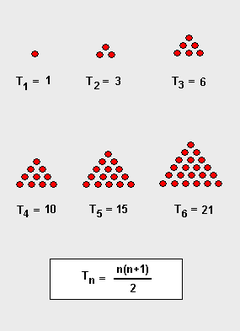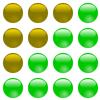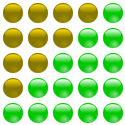Triangular number
A triangular number is the number of dots in an equilateral triangle evenly filled with dots. For example, three dots can be arranged in a triangle; thus three is a triangle number. The nth triangle number is the number of dots in a triangle with n dots on a side.
A triangle number is, equivalently, the sum of the n natural numbers from 1 to n.

The rightmost term in the formula, consisting of the two numbers n + 1 and 2 on top of each other within parentheses, is the standard mathematical notation for a binomial coefficient that counts the number of distinct pairs to be selected from n + 1 objects. In this form the triangular number Tn solves the "handshake problem" of counting the number of handshakes if each person in a room full of n + 1 total people shakes hands once with each other person.
The sequence of triangular numbers (sequence A000217 in OEIS) for n = 1, 2, 3... is:
- 1, 3, 6, 10, 15, 21, 28, 36, 45, 55, ....
Contents |
Relations to other figurate numbers
Triangular numbers have a wide variety of relations to other figurate numbers.
Most simply, the sum of two consecutive triangular numbers is a square number, with the sum being the square of the difference between the two. Algebraically,
Alternatively, the same fact can be demonstrated graphically:
| 6 + 10 = 16 |  |
10 + 15 = 25 |  |
There are infinitely many triangular numbers that are also square numbers; e.g., 1, 36. Some of them can be generated by a simple recursive formula:
 with
with 
All square triangular numbers are found from the recursion
 with
with  and
and 
Also, the square of the nth triangular number is the same as the sum of the cubes of the integers 1 to n.
The sum of the n first triangular numbers is the nth tetrahedral number,
More generally, the difference between the nth m-gonal number and the nth (m + 1)-gonal number is the (n - 1)th triangular number. For example, the sixth heptagonal number (81) minus the sixth hexagonal number (66) equals the fifth triangular number, 15. Every other triangular number is a hexagonal number. Knowing the triangular numbers, one can reckon any centered polygonal number: the nth centered k-gonal number is obtained by the formula
where T is a triangular number.
The difference of two positive triangular numbers is a trapezoidal number.
Other properties
Triangular numbers correspond to the 1st-order case of Faulhaber's formula.
Every even perfect number is triangular, given by the formula

- where Mp is a Mersenne prime, and no odd perfect numbers are known, hence all known perfect numbers are triangular.
In base 10, the digital root of a triangular number is always 1, 3, 6 or 9. Hence every triangular number is either divisible by three or has a remainder of 1 when divided by nine:
- 6 = 3×2,
- 10 = 9×1+1,
- 15 = 3×5,
- 21 = 3×7,
- 28 = 9×3+1,
- ...
The inverse of the statement above is, however, not always true. For example, the digital root of 12, which is not a triangular number, is 3 and divisible by three.
The sum of the reciprocals of all the triangular numbers is:
This can be shown by using the basic sum of a telescoping series:
Two other interesting formulas regarding triangular numbers are:
and
both of which can easily be established either by looking at dot patterns (see above) or with some simple algebra.
In 1796, German mathematician and scientist Carl Friedrich Gauss discovered that every positive integer is representable as a sum of at most three triangular numbers, writing in his diary his famous words, "EΥΡHKA! num = Δ + Δ + Δ" Note that this theorem does not imply that the triangular numbers are different (as in the case of 20=10+10), nor that a solution with three nonzero triangular numbers must exist. This is a special case of Fermat's Polygonal Number Theorem.
The largest triangular number of the form 2k-1 is 4095, see Ramanujan–Nagell equation.
Wacław Franciszek Sierpiński posed a question if there exist four distinct triangular numbers in geometric progression. It was conjectured by Polish mathematician Kazimierz Szymiczek to be false. This conjecture was proven by Fang and Chen in 2007.[1][2]
Triangular roots and tests for triangular numbers
By analogy with the concept of square roots of x, one can define the triangular roots of x as:
An integer x is triangular exactly if 8x + 1 is a square. Equivalently, if the positive triangular root n of x is an integer, then x is the nth triangular number.
This test is based on the identity
See also
- Metcalfe's law, that the complexity of communication between a group of people grows with the number of pairs of people, a triangular number.
- Miraculous Draught of Fish, an episode from the Gospels involving the triangular number 153; the triangular form of this number was thought by Saint Augustine to be important in interpreting this passage.[3]
Notes
- ↑ Chen, Fang: Triangular numbers in geometric progression
- ↑ Fang: Nonexistence of a geometric progression that contains four triangular numbers
- ↑ Owen, O. T. (1988), "One Hundred and Fifty Three Fishes", Expository Times 100: 52–54, doi:10.1177/001452468810000204.
External links
- Triangular numbers at cut-the-knot
- There exist triangular numbers that are also square at cut-the-knot
- Weisstein, Eric W., "Triangular Number" from MathWorld.









